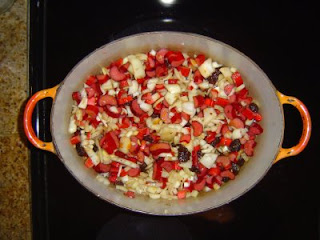Possum up a 'simmon tree
Raccoon on the ground
Possum up a 'simmon tree
Shake dem 'simmons down
~ traditional lyrics
Possum up a 'simmon tree
Shake dem 'simmons down
~ traditional lyrics

 We had an unannounced caller this week. Late one night as I finished work at my desk, I heard a thud followed by scattery, frantic scrambling through our open back door. Leaning back in the chair to get a better view (uncapped pen in hand in case I needed to go all Jason Bourne on an unwelcome guest), I espied a possum, frozen as he regarded me from his precarious perch, his long-nailed little paws clutching at the top of the patio fence. I snapped a few shots of him as he ambled a little more gracefully away, past the rosemary, peppers, and lemon verbena. And then, like a freaky little Keyser Söze, he was gone.
We had an unannounced caller this week. Late one night as I finished work at my desk, I heard a thud followed by scattery, frantic scrambling through our open back door. Leaning back in the chair to get a better view (uncapped pen in hand in case I needed to go all Jason Bourne on an unwelcome guest), I espied a possum, frozen as he regarded me from his precarious perch, his long-nailed little paws clutching at the top of the patio fence. I snapped a few shots of him as he ambled a little more gracefully away, past the rosemary, peppers, and lemon verbena. And then, like a freaky little Keyser Söze, he was gone.No, not an opossum. Horace Kephart (Camp Cookery, 1910) writes, and I concur: “To call a possum an opossum, outside of a scientific treatise, is an affectation.”
One could marvel in the wonders of nature at such a moment, could take comfort in the knowledge that even in cities, wildlife still flourishes ("why, two of those mischievous little scamps at our old place used to positively gorge themselves on guavas from the trees out back of a summer evening"), or one could, in a soft-hearted moment, realize that, though odd-looking, possums can be almost…cuddly.
Me? I thought of sweet potatoes. See, I’ve lived in a few places where possums may just grace a table or two. Don’t get your backs all up: muskrats are trapped regularly just outside Manhattan…yes, for eating. Not a chance I’d attack a possum with an uncapped pen, though, so I let it slide into the night.
 Of possum meat, Joe Dabney (friend to moonshiner and revenue agent alike) wrote in Smokehouse Ham, Spoon Bread, and Scuppernong Wine:
Of possum meat, Joe Dabney (friend to moonshiner and revenue agent alike) wrote in Smokehouse Ham, Spoon Bread, and Scuppernong Wine:Mountain people consider the shy possum to be a superb game meat, with a wonderful wild taste, and [it] is often served with sweet potatoes or with chestnuts.He then goes to describe a few ways of cooking, and notes especially to remove its scent glands before cooking.
Ernest Matthew Mickler, in White Trash Cooking, also notes “There’s only one thing to serve possum with—sweet potatoes.” Since Mickler lifted the supposed white trash recipe from the tony Junior League of Charleston though their recipe book Charleston Receipts, I’ll lift it from him and recommend that you buy both books, perhaps as a bridal shower gift.
Roast Possum
Possum should be cleaned as soon as possible after shooting. It should be hung for 48 hours and is then ready to be skinned and cooked. The meat is light-colored and tender. Excess fat may be removed, but there is no strong flavor or odor contained in the fat.
1 possum
1 onion, chopped
1 Tbl fat
¼ tsp Worcestershire sauce
1 cup breadcrumbs
1 hard-boiled egg, chopped
1 tsp salt
water
Rub possum with salt and pepper. Brown onion in fat. Add possum liver and cook until tender. Add breadcrumbs, Worcestershire sauce, egg, salt and water. Mix thoroughly and stuff possum. Truss like a fowl. Put in roasting pan with bacon across back and pour [one] quart of water into the pan. Roast uncovered in a moderate (350 degrees) oven until tender, about 2 1/2 hours. Serve with sweet potatoes.
Oh ~ and since someone’s bound to ask: No, I’m not going to eat him if he comes back. Not when the fridge is stocked with three pounds of bratwurst, a case of beer, several chickens, and enough vegetables to get us through the holiday weekend. It’s too damn hot to roast sweet potatoes or marsupials, anyway. I’m just sayin. You know. If you ever need a possum recipe, there you go.
Goes well with:
- It’s all well and good to joke about white trash (the Blue Collar comics bank on it), but don’t dismiss Mickler’s book as sheer kitsch or merely a goof, though it is in part both those things. John T. Edge makes an eloquent case for Mickler as an intellectual, if not actual, peer of James Agee and photographer Walker Evans in his 2006 Oxford American article Let Us Now Praise Fabulous Cooks.
.



















